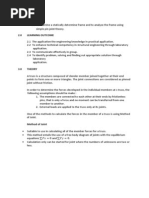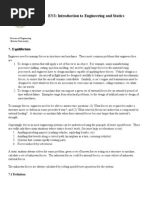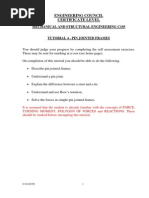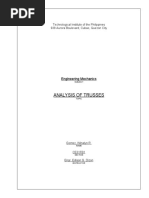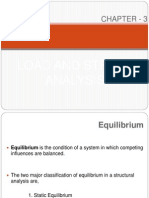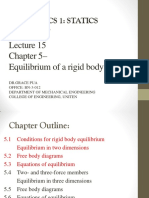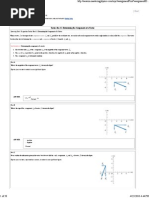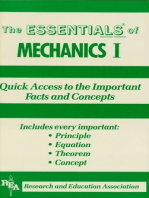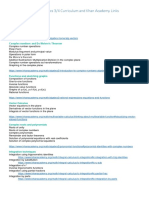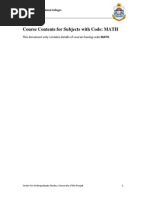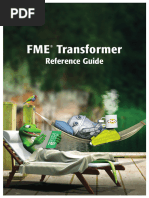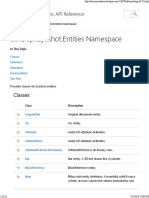HW 3 Solutions
HW 3 Solutions
Uploaded by
Nathaniel LounsburyCopyright:
Available Formats
HW 3 Solutions
HW 3 Solutions
Uploaded by
Nathaniel LounsburyCopyright
Available Formats
Share this document
Did you find this document useful?
Is this content inappropriate?
Copyright:
Available Formats
HW 3 Solutions
HW 3 Solutions
Uploaded by
Nathaniel LounsburyCopyright:
Available Formats
MasteringEngineering: Assignment Print View
http://session.masteringengineering.com/myct/assignmentPrintView?assig...
MasteringEngineering: Assignment Print View
http://session.masteringengineering.com/myct/assignmentPrintView?assig...
Student View
Summary View
Diagnostics View
Print View with Answers
Edit Assignment
Settings per Student
HW #3
Due: 11:30pm on Sunday, September 18, 2011
Note: You will receive no credit for late submissions. To learn more, read your instructor's Grading Policy
The Free-Body Diagram
Description: Learning Goal: To understand how to construct a free-body diagram for an object that can be treated as a particle. In this tutorial, students isolate the object of interest, identify the forces acting on the object, and draw the free-body diagram of the object. (vector applet) Learning Goal: To understand how to construct a free-body diagram for an object that can be treated as a particle. The free-body diagram is a fundamental tool used in engineering mechanics. It is simply a sketch that shows the particle free from its surroundings with all forces that act on the particle. By correctly constructing a free-body diagram, one can account for all of the forces in the equations of equilibrium. It is often helpful to draw an enclosing circle (or loop) around the object(s) of interest and account for (a) forces in cables cut by the circle, (b) reaction forces between the object and any supports at the boundary of the circle, and (c) the weight of the object(s) enclosed by the circle. Part A As shown, a crate with weight hangs from a support rope that is tied to two other ropes at C. The two ropes are attached to tie-downs
mounted on the ceiling at points A and B. Complete the free-body diagram of C by drawing the forces that act on it.
Hint A.1
How to approach the problem
When drawing a free-body diagram, consider the object of interest as a particle and follow these steps: Determine the cut that isolates point C from its surroundings. Identify the forces acting on point C. Include the identified forces in the free-body diagram. Hint A.2 Determine the cut that isolates point C It is important to note the differences between drawing a free-body diagram on paper and drawing a free-body diagram in this tutorial. On paper, you would include only the isolated components inside of the dashed circle above. In the tutorial, you are given a diagram and asked to complete the free-body diagram by including only the relevant forces around point C. Although the free-body diagram you draw on paper and the one in this tutorial may look different, the forces that are included should be the same.
It is useful to consider point C isolated or cut "free" from the remainder of the system. The diagrams below show a dashed circle that isolates different parts of the system. Which cut best isolates point C? ANSWER:
Hint A.3
Identify the forces that act directly on C
Identify the forces acting on point C.
Select all that apply.
ANSWER: tension from point C to point A the reaction force at point A tension from point C to point B the weight of the crate the reaction force at point B tension from point C to the crate
1 of 17
9/19/2011 8:15 AM
2 of 17
9/19/2011 8:15 AM
MasteringEngineering: Assignment Print View
http://session.masteringengineering.com/myct/assignmentPrintView?assig...
MasteringEngineering: Assignment Print View
http://session.masteringengineering.com/myct/assignmentPrintView?assig...
The forces of interest are all of the forces that act directly on the object of interest. The forces that act directly on point C are the three tensions in the three ropes. Although the crate's weight creates the tension in the rope between the crate and point C, the weight does not act directly on point C and is, therefore, not included in the free-body diagram.
Draw your vectors starting at point C. The orientation of the vectors will be graded. The exact length of the vectors will not be graded.
ANSWER:
View
Part B As shown, a light hangs from a chain that is connected to a ring held in place by two ropes. One rope is attached directly to a tie-down on a wall, and the other rope passes over a pulley that is mounted on the ceiling before being attached to a tie-down on the opposite wall. Complete the free-body diagram of the light by drawing the forces that act on it.
Hint B.1
How to approach the problem
When drawing the free-body diagram, consider the object of interest as a particle and follow these steps: Determine the cut that isolates point D from its surroundings. Identify the forces acting on point D. Include the identified forces in the free-body diagram. Hint B.2 Determine the cut that isolates the light Hint B.3 Identify all the forces that act directly on the light
The diagrams below show a dashed circle that isolates different parts of the system. Which cut would best isolate point D? ANSWER:
Based on the diagram that isolates the light from the remainder of the system, what forces should be included in the free-body diagram?
Select all that apply.
ANSWER: , the tension in the rope between the pulley and the wall , the tension in the rope between the ring and the wall
3 of 17
9/19/2011 8:15 AM
4 of 17
9/19/2011 8:15 AM
MasteringEngineering: Assignment Print View
http://session.masteringengineering.com/myct/assignmentPrintView?assig...
MasteringEngineering: Assignment Print View
http://session.masteringengineering.com/myct/assignmentPrintView?assig...
, the weight of the light , the tension in the chain between the ring and the light , the tension in the rope between the ring and the pulley
When drawing a free-body diagram, include all the forces that act directly on the object of interest.
Draw the weight force vector starting at point D. Draw the tension force vectors starting at the point of contact between the chain and the light. The orientation of the vectors will be graded. The exact length of the vectors will not be graded.
ANSWER:
View
Part C Given the same light system from Part B, complete the free-body diagram of the ring by drawing the forces that act directly on it. Hint C.1 How to approach the problem
When drawing the free-body diagram, consider the object of interest as a particle and follow these steps in drawing the free-body diagram: Determine the cut that isolates point C from its surroundings. Identify the forces acting on point C. Include the identified forces in the free-body diagram. Hint C.3 Hint C.2 Determine the cut that isolates the ring Based on the diagram that isolates the ring from the remainder of the apparatus, what forces should be included in the free-body diagram? The diagrams below show a dashed circle that isolates different parts of the system. Which cut best isolates point C? ANSWER: Identify all the forces that act directly on the ring
Select all that apply.
ANSWER: , the tension in the rope between the pulley and the wall , the weight of the light , the tension in the chain between the ring and the light , the tension in the rope between the ring and the wall , the tension in the rope between the ring and the pulley
When drawing a free-body diagram, include all the forces that act directly on the object of interest.
Draw each force vector starting at ring C. The orientation of the vectors will be graded. The exact length of the vectors will not be graded.
5 of 17
9/19/2011 8:15 AM
6 of 17
9/19/2011 8:15 AM
MasteringEngineering: Assignment Print View
http://session.masteringengineering.com/myct/assignmentPrintView?assig...
MasteringEngineering: Assignment Print View
http://session.masteringengineering.com/myct/assignmentPrintView?assig...
ANSWER: View
View
By identifying the properties of a force system, basic assumptions can be made that simplify the analysis of the system. Coplanar force systems require force balances in only two dimensions, eliminating the need for a third balance equation. Collinear force systems are one dimensional and the forces can be combined as scalars. Concurrent force systems intersect at a single point and do not require a moment analysis. In a parallel force system, the forces can be combined as scalars but any separation will necessitate an additional moment analysis of the system.
Part B
Coplanar Force Systems
Description: Includes Math Remediation. Learning Goal: To understand how to establish a particle's free-body diagram in a coplanar force system and to apply the equations of equilibrium to solve for unknowns. In this tutorial, students identify terms to describe a force system, draw a free-body diagram to relate the forces in a force system, and use the equilibrium conditions to find unknown quantities. (vocab applet) Learning Goal: To understand how to establish a particle's free-body diagram in a coplanar force system and to apply the equations of equilibrium to solve for unknowns. In a coplanar force system, a particle is subjected to forces that lie in a single plane. If that plane is the xy plane, then the conditions of equilibrium are met when
A tugboat tows a ship at a constant velocity. The tow harness consists of a single tow cable attached to the tugboat at point A that splits at point B and attaches to the ship at points C and D. The two rope segments BC and BD angle away from the center of the ship at angles of = 25.0 and = 25.0 , respectively. The tugboat pulls with a force of 1600 . What are the tensions and in the rope segments BC and BD?
For this vector equation to be satisfied, the force vector's x and y components must be equal to zero:
Part A Three identical objects in three different systems each have three forces acting on them. What word best completes the following sentences that describe each force system? Hint B.1 How to approach the problem
Whereas the tow harness system is three dimensional, all the ropes, and, therefore, the tensions in those ropes are coplanar. They exist entirely in a plane and can be treated as two-dimensional forces. In this case, you can treat the rope segment AB as lying along the y axis with pointing in the negative y direction. Any forces that are perpendicular to the rope segment AB will be in the x direction. Determine all of the forces in each direction in the plane and apply the conditions for equilibrium. This will require a system of equations that can be used to find the two unknown quantities: the tensions in the rope segments BC and BD.
Hint B.2
Draw the free-body diagram
Complete the free-body diagram of B by drawing the forces that act on it at the origin of the axes, as if viewing the system from above the tow harness.
Draw your vectors starting at point B. The orientation of the vectors will be graded. The exact length of the vectors will not be graded. Assume that points in the negative y direction.
Hint A.1 How to approach the problem ANSWER:
Learning the terminology used to describe force systems helps explain the differences encountered in these systems. The term "concurrent" is used when the lines of action of the forces of interest intersect at one point. Conversely, the term "nonconcurrent" is used when the lines of action of the forces of interest do not intersect at one point. The term "collinear" is used when the forces of interest have the same line of action. The term "parallel" is used when all of the lines of action of the forces of interest never intersect. The term "perpendicular" is used when the lines of action of two or more forces of interest intersect at 90 angles.
Match the words in the left column to the appropriate blanks in the sentences on the right. Make certain each sentence is complete before submitting your answer.
ANSWER: Hint B.3
View
Find an expression for and rearrange the equation to solve for in terms of the tension and the angles and .
Apply the conditions for equilibrium to
Hint B.3.1
Find an expression for
7 of 17
9/19/2011 8:15 AM
8 of 17
9/19/2011 8:15 AM
MasteringEngineering: Assignment Print View
http://session.masteringengineering.com/myct/assignmentPrintView?assig...
MasteringEngineering: Assignment Print View
http://session.masteringengineering.com/myct/assignmentPrintView?assig...
What is the sum of all the forces in the x direction in terms of the tension the angles and ?
in rope segment BC, the tension
in rope segment BD, and
Hint B.5
Determine in the rope segment BA?
What is the tension
Express your answer in terms of
ANSWER: =
, , and
Express your answer numerically in pounds to four significant figures.
ANSWER: =
Express your answers numerically in pounds to three significant figures separated by a comma.
ANSWER: Hint B.3.2 The conditions for equilibrium , = The conditions for equilibrium require that the sum of the forces in each direction be zero:
Express your answer in terms of
ANSWER: =
, , and
The analysis of this problem has been simplified by realizing that the forces are coplanar. Whereas the tow harness is three dimensional, all the ropes and tensions are in a single plane. This reduces the problem to finding the sum of the forces in only two dimensions. The problem is further simplified by identifying the forces as concurrent. All the forces intersect at a single point, requiring the forces to be summed only at that point. After the system is simplified, the free-body diagram was drawn to determine all the forces that interact at point B. The x and y components of the forces were then summed:
Because Find an expression for and use your equation for and . to rearrange the equation to solve for in terms of the tension Part C
is given in the problem, there are two equations and two unknowns,
and
. By applying the conditions of equilibrium, the
system of equations can be solved to find these unknowns. Hint B.4
Apply the conditions for equilibrium to in rope segment BA and the angles Hint B.4.1
Rope BCA passes through a pulley at point C and supports a crate at point A. Rope segment CD supports the pulley and is attached to an eye anchor embedded in a wall. Rope segment BC creates an angle of = 53.0 with the floor and rope segment CD creates an angle with the horizontal. If both ropes BCA and CD can support a maximum tensile force system can support? What is the angle in rope segment BC, the tension in rope segment BD, the required for equilibrium? = 165 , what is the maximum weight of the crate that the
Find an expression for
What is the sum of all the forces in the y direction in terms of the tension tension in rope segment BA, and the angles and ?
Express your answer in terms of
ANSWER: =
, and
Hint B.4.2
The conditions for equilibrium
The conditions for equilibrium require that the sum of the forces in each direction be zero: Hint C.1 How to approach the problem
Express your answer in terms of
ANSWER:
, and
The system of forces is coplanar; thus, there are two equations of force equilibrium that can be solved to find the two unknowns: the maximum weight and the angle .
Hint C.2 =
Draw the free-body diagram of C
Complete the free-body diagram of C by drawing the forces that act on the pulley.
Draw your vectors starting at the center of the pulley. The orientation of the vectors will be graded. The exact length of the vectors will not be graded.
ANSWER:
9 of 17
9/19/2011 8:15 AM
10 of 17
9/19/2011 8:15 AM
MasteringEngineering: Assignment Print View
http://session.masteringengineering.com/myct/assignmentPrintView?assig...
MasteringEngineering: Assignment Print View
http://session.masteringengineering.com/myct/assignmentPrintView?assig...
ANSWER:
= View
Hint C.3
Relate the tensions and the weight in rope segment CA, the tension in rope segment CB, the tension in rope segment Hint C.4.3 The conditions for equilibrium
Which of the following is true about the tension CD, and the weight of the crate ?
The conditions for equilibrium require that the sum of the forces in each direction be zero:
ANSWER: Use the trigonometric identity and the equilibrium conditions to express in terms of and ..
Express your answer in terms of
ANSWER: = The two rope segments CA and CB are parts of the same rope. Because the tension is the same throughout the rope, the tensions in the two segments are the same ( ). The only two forces that act at point A are the weight and the tension in rope segment CA; therefore, the magnitudes of these two forces must be equal if the system is in equilibrium. Hint C.5 Hint C.4 Find an expression for in terms of the known valuesthe maximum rope tension Find an expression for
and
Use the condition for equilibrium in the x direction to find an expression for the angle maximum rope tension , and the angle .
in terms of the maximum weight of the crate
, the
Apply the conditions for equilibrium and express the maximum weight of the crate and the angle Hint C.4.1 .
Express your answer in terms of
ANSWER: = in rope segment CB, the tension in rope segment CD, and
, and
Find an expression for
What is the sum of all the forces in the x direction in terms of the tension the angles and ?
Express your answer in terms of
ANSWER: =
, , and
Express your answers numerically in pounds and degrees to three significant figures separated by a comma.
ANSWER:
Hint C.4.2
Find an expression for , what is the sum of all the forces in the y direction in terms of the tension and ? in rope segment CB, the The analysis of this problem has been simplified by realizing that the forces are coplanar. This reduces the problem to finding the sum of the forces in only two dimensions. The problem is further simplified by identifying the forces as concurrent. All the forces intersect at a single point, requiring the forces to be summed only at that point. After the system is simplified, the free-body diagram was drawn to determine all the forces that interact at point C. The x and y components of the forces were then summed:
Keeping in mind that tension
in rope segment CD, and the angles The tension in rope BCA
Hint C.4.2.1
Because the rope segments CB and CA are part of the same rope, the tension throughout the rope is the same:
Because CB and CA are part of the rope BCA,
. The tension in this rope must also be equal to the weight of the crate,
, so
. The maximum tension for the ropes and the angle unknowns, and
are given in the problem. There are then two equations and two
. By applying the conditions of equilibrium, the system of equations can be solved to find these unknowns.
Express your answer in terms of
, , and
Problem 3.12
11 of 17
9/19/2011 8:15 AM
12 of 17
9/19/2011 8:15 AM
MasteringEngineering: Assignment Print View
http://session.masteringengineering.com/myct/assignmentPrintView?assig...
MasteringEngineering: Assignment Print View
http://session.masteringengineering.com/myct/assignmentPrintView?assig...
Description: (a) Draw a free-body diagram of the ring at A. (b) If block B weighs W_B and block C weighs W_C, determine the required weight of block D for equilibrium. (c) Determine the angle theta. Part A Draw a free-body diagram of the ring at A.
Draw the vectors starting at the black dot. The location and orientation of the vectors will be graded. The length of the vectors will not be graded.
ANSWER:
ANSWER:
View
Part B Draw a free-body diagram of the ring at B.
View
Draw the vectors starting at the black dot. The location and orientation of the vectors will be graded. The length of the vectors will not be graded.
ANSWER:
Part B If block B weighs 210 and block C weighs 120 , determine the required weight of block D for equilibrium.
Express your answer with the appropriate units.
ANSWER: = View
Part C Determine the tension developed in wire CD required for equilibrium of the 30 Part C Determine the angle . cylinder E and the 70 cylinder F.
Express your answer with the appropriate units.
ANSWER: =
Express your answer with the appropriate units.
ANSWER: =
Part D Determine the tension developed in wire CB.
Express your answer with the appropriate units.
ANSWER:
Problem 3.26
Description: (a) Draw a free-body diagram of the ring at C. (b) Draw a free-body diagram of the ring at B. (c) Determine the tension developed in wire CD required for equilibrium of the 30 lb cylinder E and the W_F cylinder F. (d) Determine the tension... Part A Draw a free-body diagram of the ring at C. Part E
Draw the vectors starting at the black dot. The location and orientation of the vectors will be graded. The length of the vectors will not be graded.
13 of 17
9/19/2011 8:15 AM
14 of 17
9/19/2011 8:15 AM
MasteringEngineering: Assignment Print View
http://session.masteringengineering.com/myct/assignmentPrintView?assig...
MasteringEngineering: Assignment Print View
http://session.masteringengineering.com/myct/assignmentPrintView?assig...
Determine the tension developed in wire BA.
Determine the magnitude of the force acting along the axis of strut AC.
Express your answer with the appropriate units.
ANSWER: =
Express your answer with the appropriate units.
ANSWER: =
Part D Part F Determine the angle . Determine the magnitude of the force acting along the axis of strut AD.
Express your answer with the appropriate units.
ANSWER: =
Express your answer with the appropriate units.
ANSWER: =
Problem 3.59
Description: (a) Draw a free-body diagram of the ring at A. (b) If each cable can withstand a maximum tension of T_max, determine the largest mass of the cylinder for equilibrium. Part A Draw a free-body diagram of the ring at A.
Problem 3.53
Description: (a) Draw a free-body diagram of the chain at A. (b) Determine the magnitude of the force acting along the axis of strut AB needed to support the 500-kg block. (c) Determine the magnitude of the force acting along the axis of strut AC. (d)... Part A Draw a free-body diagram of the chain at A.
Draw the vectors starting at the black dot. The location and orientation of the vectors will be graded. The length of the vectors will not be graded.
Draw the vectors starting at the black dot. The location and orientation of the vectors will be graded. The length of the vectors will not be graded.
ANSWER:
ANSWER:
View
View
View
Part B If each cable can withstand a maximum tension of 2000 , determine the largest mass of the cylinder for equilibrium.
Part B Determine the magnitude of the force acting along the axis of strut AB needed to support the 500block.
Express your answer with the appropriate units.
ANSWER: =
Express your answer with the appropriate units.
ANSWER: =
Part C
Score Summary:
Your score on this assignment is 0%.
15 of 17
9/19/2011 8:15 AM
16 of 17
9/19/2011 8:15 AM
You might also like
- IA Mathematics SL Volume by RevolutionDocument28 pagesIA Mathematics SL Volume by Revolutionhumanistale86% (7)
- Beam Analysis Using The Stiffness Method in MATLAB ProgramDocument14 pagesBeam Analysis Using The Stiffness Method in MATLAB ProgramUpadesh Shrestha100% (3)
- Qualitative Structural Analysis of Beams and FramesDocument8 pagesQualitative Structural Analysis of Beams and FramesNeven Ahmed HassanNo ratings yet
- Mechanics CH-4 MarkosDocument13 pagesMechanics CH-4 MarkosGadisaNo ratings yet
- Free Body Diagram and Quasi-Static, Two-Dimensional Load Analysis Free BodyDocument10 pagesFree Body Diagram and Quasi-Static, Two-Dimensional Load Analysis Free Bodyabdo alsyedNo ratings yet
- Force in TrussDocument4 pagesForce in TrussFatin Amira Abd Manan100% (1)
- JJ205 Engineering Mechanic Chapter 3 Jj205Document5 pagesJJ205 Engineering Mechanic Chapter 3 Jj205Ah TiangNo ratings yet
- Engineering MechanicsDocument80 pagesEngineering MechanicsVv4H100% (2)
- Week 6 - Frames+Friction+FluidDocument60 pagesWeek 6 - Frames+Friction+Fluidiwhy_No ratings yet
- Whitepaper - Bolted ConnectionsDocument18 pagesWhitepaper - Bolted ConnectionsOğuzhan KocaNo ratings yet
- Shear and Moment Diagram - Wikipedia, The Free EncyclopediaDocument10 pagesShear and Moment Diagram - Wikipedia, The Free EncyclopediaPrabhat MishraNo ratings yet
- Introduction To Statics - EquilibriumDocument35 pagesIntroduction To Statics - EquilibriumAjinkya KulkarniNo ratings yet
- "Chapter 9 - Influence Lines For Statically Determinate Structures" in "Structural Analysis" On Manifold @tupressDocument33 pages"Chapter 9 - Influence Lines For Statically Determinate Structures" in "Structural Analysis" On Manifold @tupressrpsirNo ratings yet
- Basic TheoryDocument40 pagesBasic TheorymohammedetaNo ratings yet
- Structural Analysis: Engr. John Marco I. MatiraDocument28 pagesStructural Analysis: Engr. John Marco I. MatiraAIMNo ratings yet
- CE 311 MODULE 5 - Structural Analysis of TrussesDocument11 pagesCE 311 MODULE 5 - Structural Analysis of TrussesBryanHarold BrooNo ratings yet
- Fom Lec Week 6Document35 pagesFom Lec Week 6nishan_ravin0% (1)
- LectureNotes_3.2_Zero-forceMembersDocument16 pagesLectureNotes_3.2_Zero-forceMembersmichelassamba3No ratings yet
- Engineering Mechanics Statics: Yousif J. BasDocument22 pagesEngineering Mechanics Statics: Yousif J. Basalnd azadNo ratings yet
- 5 - Structural AnalysisDocument46 pages5 - Structural AnalysisHawsar Omer HamaNo ratings yet
- 21Document47 pages21physicsdocs56% (9)
- CVE 309 Theory of structure LECTURE NOTEDocument43 pagesCVE 309 Theory of structure LECTURE NOTEb5ypqx4z24100% (1)
- Mechanics CH-3 MarkosDocument16 pagesMechanics CH-3 MarkosGadisa100% (1)
- Engineering Council Certificate Level: Mechanical and Structural Engineering C105Document0 pagesEngineering Council Certificate Level: Mechanical and Structural Engineering C105darkyrose27No ratings yet
- 511 ProjectDocument14 pages511 Projectziaurahmanali2No ratings yet
- Unit 2 - Part 3 (Focus On Calculation Question Types)Document28 pagesUnit 2 - Part 3 (Focus On Calculation Question Types)BonoloNo ratings yet
- Bending Moment Mechanical Engineering Homework HelpDocument8 pagesBending Moment Mechanical Engineering Homework Helpg3w33y1q100% (1)
- Geometry Expressions Manual PDFDocument52 pagesGeometry Expressions Manual PDFYaseen GhulamNo ratings yet
- MachineFrames SplitDocument70 pagesMachineFrames SplitRavi TilaganjiNo ratings yet
- 02 Influence Lines For BeamsDocument11 pages02 Influence Lines For BeamsSalem AlbarkiNo ratings yet
- AS1 FormatDocument97 pagesAS1 FormatgurusamyNo ratings yet
- Chapter 18 Matrix Analysis of Beams and Frames by The Direct Stiffness MethodDocument38 pagesChapter 18 Matrix Analysis of Beams and Frames by The Direct Stiffness Methodavinash35100% (1)
- Internal Forces Internal Forces Internal Forces Internal ForcesDocument54 pagesInternal Forces Internal Forces Internal Forces Internal Forcesiwhy_0% (1)
- Complete Method of Joints and Method of Sections SolutionsDocument6 pagesComplete Method of Joints and Method of Sections SolutionsmarkvalderamosNo ratings yet
- Engineering Mechanics (Analysis of Trusses)Document5 pagesEngineering Mechanics (Analysis of Trusses)Ema MiguelNo ratings yet
- Structure NotesDocument9 pagesStructure NotesIslam MohamedNo ratings yet
- DocumentDocument12 pagesDocumentSrijan MishraNo ratings yet
- BME 1223Lec4LEDocument7 pagesBME 1223Lec4LEyazan alNo ratings yet
- Chapter - 3: Load and Stress AnalysisDocument23 pagesChapter - 3: Load and Stress AnalysissandeshlikesNo ratings yet
- Chapter IDocument12 pagesChapter InvnrevNo ratings yet
- WWW Engin Brown Edu Courses En3 Notes Statics Equilibrium EqDocument52 pagesWWW Engin Brown Edu Courses En3 Notes Statics Equilibrium EqArunachalam NarayananNo ratings yet
- Chapter 13 Skill BuildingDocument26 pagesChapter 13 Skill BuildingNKHICQ1mEbIwNo ratings yet
- Intro To Plastic AnalysisDocument12 pagesIntro To Plastic AnalysisTarun SamaNo ratings yet
- Chapter Six: Analysis of Analysis of StructuresDocument33 pagesChapter Six: Analysis of Analysis of StructuresAditya Dsr100% (1)
- UntitledDocument26 pagesUntitledreema omarNo ratings yet
- Equilibrium of Rigid BodyDocument41 pagesEquilibrium of Rigid BodyJaya KarthigaaNo ratings yet
- MME2202 CourseReviewDocument5 pagesMME2202 CourseReviewMatt BrezinaNo ratings yet
- Module 3 (Statics Part 2)Document5 pagesModule 3 (Statics Part 2)William MoriartyNo ratings yet
- TrussDocument7 pagesTrussa_j_sanyal259No ratings yet
- 17. Free-body Diagrams And Equilibrium Friction And Its Applications Including RollingDocument7 pages17. Free-body Diagrams And Equilibrium Friction And Its Applications Including RollingFranklin Daniel XalxoNo ratings yet
- Exercises 1: Direction of Each Force Using An Algebraic or Vector Method, As SpecifiedDocument5 pagesExercises 1: Direction of Each Force Using An Algebraic or Vector Method, As SpecifiedNguyễn Thái Phương ThảoNo ratings yet
- Week 2 - Load and Stress AnalysisDocument2 pagesWeek 2 - Load and Stress AnalysisAnonymous M2ZVOCfpNo ratings yet
- Method of Joints: Members Subjected To Forces Tension and CompressionDocument7 pagesMethod of Joints: Members Subjected To Forces Tension and CompressionGemma BalictarNo ratings yet
- Theory of Structure MicroprojectDocument5 pagesTheory of Structure MicroprojectXyz AvmcNo ratings yet
- MP3 FFDocument20 pagesMP3 FFabeck1713100% (2)
- Chapter 5 Analysis of StructureDocument20 pagesChapter 5 Analysis of StructureRenu SekaranNo ratings yet
- Planar Linkage Synthesis: A modern CAD based approachFrom EverandPlanar Linkage Synthesis: A modern CAD based approachNo ratings yet
- Turbo SRMDocument786 pagesTurbo SRMYang HongNo ratings yet
- 8-5 Dot and Cross Products of Vectors in Space-3Document30 pages8-5 Dot and Cross Products of Vectors in Space-3lunalimar7No ratings yet
- 3D Coordinate GeometryDocument13 pages3D Coordinate GeometryckpadayaoNo ratings yet
- VCE Specialist Mathematics Curriculum and Khan Academy LinksDocument2 pagesVCE Specialist Mathematics Curriculum and Khan Academy LinksValerie GanNo ratings yet
- Dip Meter LogDocument16 pagesDip Meter LogSoma Sankar100% (2)
- Mathematics 3D Geometry MCQDocument6 pagesMathematics 3D Geometry MCQrasheedshaikh2003100% (5)
- Anderson Chapter 6Document22 pagesAnderson Chapter 6saintanddevilNo ratings yet
- Lesson 6c Vectors Operations (Cross Product and Scalar Triple Product)Document14 pagesLesson 6c Vectors Operations (Cross Product and Scalar Triple Product)angelo berinaNo ratings yet
- Code MATH Course DetailsDocument80 pagesCode MATH Course DetailsMALIK BILALNo ratings yet
- Download full Computers Visualization and History How New Technology Will Transform Our Understanding of the Past 2nd Edition David J Staley ebook all chaptersDocument85 pagesDownload full Computers Visualization and History How New Technology Will Transform Our Understanding of the Past 2nd Edition David J Staley ebook all chaptersyunlimikely100% (3)
- Vectors Basic Formula SheetDocument6 pagesVectors Basic Formula SheetChristian GaoNo ratings yet
- Complex Nonlinear Ordinary Differential Equations and GeometryDocument7 pagesComplex Nonlinear Ordinary Differential Equations and GeometryPanagiot LoukopoulosNo ratings yet
- FME-Transformer-Reference-GuideDocument62 pagesFME-Transformer-Reference-GuidePAMBCS Region IXNo ratings yet
- Format4 Tpacad 4 0 Code Definition Rev2 14 12 2016Document49 pagesFormat4 Tpacad 4 0 Code Definition Rev2 14 12 2016jerome reymondNo ratings yet
- Code FortranDocument134 pagesCode FortrancarlosquimicaNo ratings yet
- Q3 - ST in Math - 2NDDocument2 pagesQ3 - ST in Math - 2NDMINERVA SANTOSNo ratings yet
- JEE Main Syllabus at A Glance Pages PDFDocument10 pagesJEE Main Syllabus at A Glance Pages PDFSuman DewasiNo ratings yet
- VMX 42 SR NC Post Processor Englisch Version 11 - 16 - 2007Document18 pagesVMX 42 SR NC Post Processor Englisch Version 11 - 16 - 2007Wietse van der SteenNo ratings yet
- Spatial ConceptsDocument86 pagesSpatial Conceptspayaljais1047No ratings yet
- Introduction - Calculus and Vectors PortfolioDocument55 pagesIntroduction - Calculus and Vectors Portfoliofatoumatakonteh.senecaNo ratings yet
- Mathematical Elements For Computer Graphics (2Nd Edition) by David F. Rogers, J. Alan AdamsDocument9 pagesMathematical Elements For Computer Graphics (2Nd Edition) by David F. Rogers, J. Alan Adamsp23cc005No ratings yet
- 9.vector & 3-DDocument29 pages9.vector & 3-DJainNo ratings yet
- Construction Engineering 2104ENGDocument4 pagesConstruction Engineering 2104ENGSneha StephenNo ratings yet
- Green TheoremDocument18 pagesGreen TheoremkensaiiNo ratings yet
- Prilims: Syllabus of Paper I (General Studies - I)Document3 pagesPrilims: Syllabus of Paper I (General Studies - I)Akella Surya Prakasa DeekshithNo ratings yet
- Devdept - Eyeshot.entities ClassesDocument10 pagesDevdept - Eyeshot.entities Classesnirmal sutharNo ratings yet
- Solution Exercise (Line Integrals)Document12 pagesSolution Exercise (Line Integrals)iffatul mahyaNo ratings yet





